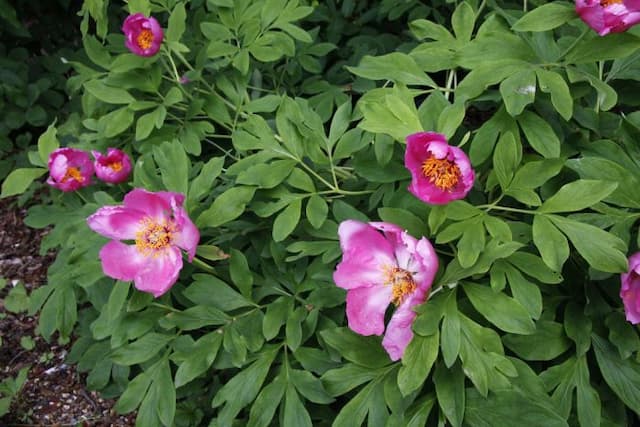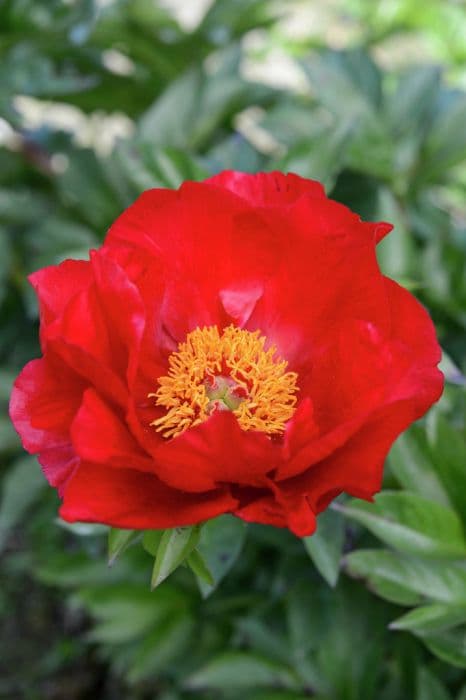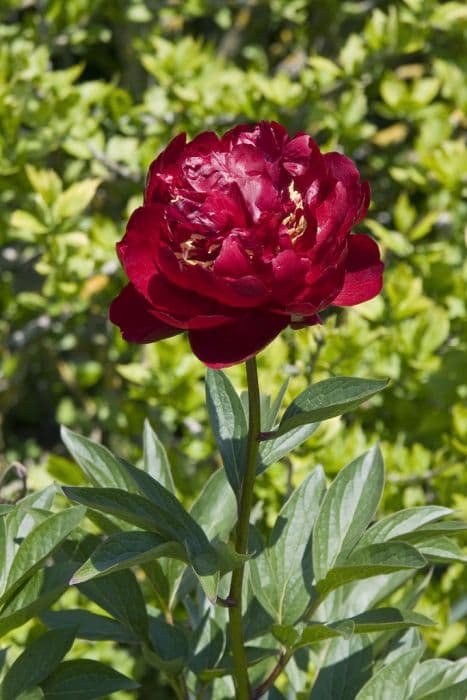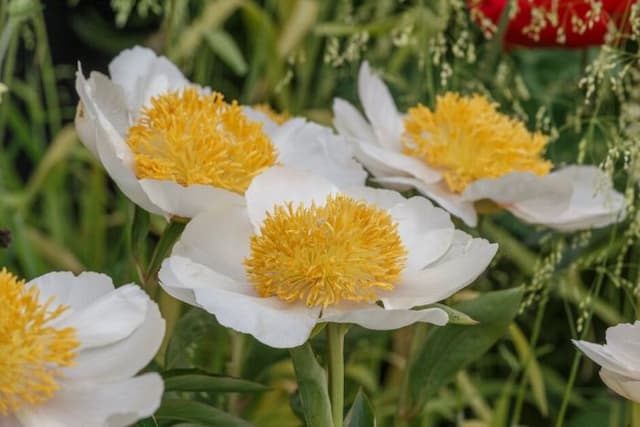Peony Paeonia lactiflora 'Moon of Nippon'

ABOUT
The 'Moon of Nippon' is a variety of peony that is admired for its striking blossoms and lush foliage. The flowers are notable for their large, full form, featuring layers of creamy-white petals that are sometimes tinged with a delicate pink hue, creating a dreamy, romantic look. These petals may refract light in a way that makes them shimmer and can feel satiny to the touch. The peony's blooms have a center of yellow stamens that contrast beautifully with the white petals, giving the flowers a radiant appearance. The blossoms emit a sweet fragrance that can permeate the air around them, enchancing the sensory appeal of the garden. Accompanying the flowers, the plant has deep green leaves that are glossy and have a leathery texture. There is a clean, defined shape to each leaf, which may have a rounded or pointed tip. The foliage provides a lush backdrop for the flowers, resulting in a striking contrast that highlights the purity and brightness of the blossoms. As a garden plant, the 'Moon of Nippon' peony brings a touch of elegance and a classic charm to the landscape, with its flowers often appearing in the late spring to early summer. The plant has a bushy habit, giving it a robust presence in the garden, and it is often included in borders, beds, or as a focal point among other ornamental shrubs.
About this plant
 Names
NamesFamily
Paeoniaceae
Synonyms
Chinese Peony, Common Garden Peony
Common names
Paeonia lactiflora.
 Toxicity
ToxicityTo humans
Paeonia lactiflora, commonly known as peony, is largely not considered toxic to humans. There is no well-documented evidence that shows significant toxic effects in humans upon ingestion of peony parts. However, as with many plants, it is still not recommended to consume parts of ornamental plants like peonies since they are not considered food plants. If large amounts of the plant were ingested, mild gastrointestinal upset could theoretically occur, though this is not commonly reported.
To pets
Peony, the common name for Paeonia lactiflora, is considered mildly toxic to pets such as dogs and cats. If a pet ingests parts of a peony plant, it may exhibit symptoms of gastrointestinal upset, which can include vomiting and diarrhea. It is advised to keep peonies out of reach of pets and to contact a veterinarian if you suspect that your pet has ingested a significant amount of the plant.
 Characteristics
CharacteristicsLife cycle
Perennials
Foliage type
Deciduous
Color of leaves
Green
Flower color
White
Height
2-3 feet (60-90 cm)
Spread
2-3 feet (60-90 cm)
Plant type
Herb
Hardiness zones
3-8
Native area
Asia
Benefits
 General Benefits
General Benefits- Ornamental Value: Paeonia lactiflora 'Moon of Nippon' is known for its large, beautiful blooms that add aesthetic appeal to gardens and landscapes.
- Longevity: Peonies are known for their ability to live for many years, sometimes even outliving the gardeners who planted them.
- Seasonal Interest: They provide exquisite flower displays in late spring to early summer and attractive foliage through the growing season.
- Pollinator Attraction: The flowers can attract pollinators such as bees and butterflies, beneficial for garden pollination.
- Cut Flowers: The blooms are highly valued for use in floral arrangements, with a long vase life making them popular in cut flower gardens.
- Low Maintenance: Once established, peonies, including this variety, often require minimal care beyond basic watering and feeding.
- Drought Tolerance: They can withstand periods of drought once fully established, making them suitable for various climates.
- Deer Resistance: Peonies are generally resistant to deer, which can help reduce damage in gardens where deer are a common issue.
- Cold Hardy: Capable of surviving in colder climates, they can withstand harsh winters, making them suitable for many temperate regions.
 Medical Properties
Medical Properties- Anti-inflammatory: Paeonia lactiflora, commonly known as the Chinese peony, has been used in traditional Chinese medicine for its potential anti-inflammatory properties.
- Analgesic: There is some evidence to suggest that the root of Chinese peony may have pain-relieving properties.
- Immunomodulatory: Some studies indicate that extracts from Chinese peony root can influence immune system function.
- Antispasmodic: Traditional use supports that Chinese peony can help alleviate muscle spasms.
- Antioxidant: Chinese peony may contain compounds that have antioxidant effects, helping to protect cells from damage.
 Air-purifying Qualities
Air-purifying QualitiesThis plant is not specifically known for air purifying qualities.
 Other Uses
Other Uses- Artistic Inspiration: Paeonia lactiflora has been depicted in traditional Asian art, particularly in Japan and China, representing beauty and honor.
- Ceremonial Use: In some cultures, the blooms of the Peony are used in wedding ceremonies due to their lush and luxurious appearance.
- Garden Design: Peonies, including 'Moon of Nippon', are often used in moon gardens, designed to be enjoyed in the evening when their bright white flowers stand out.
- Natural Dye: The petals of the Peony can be used to produce a natural dye for fabrics, yielding soft shades of pink and red.
- Perfumery: While not typically extracted for commercial perfumes, Peony scents are sometimes mimicked and used in fragrance production.
- Culinary Garnish: Peony petals are edible and can be used as a delicate garnish for salads and desserts, adding a splash of color and mild flavor.
- Feng Shui: In the practice of Feng Shui, Peonies are believed to bring good fortune and prosperity when placed in specific areas of the home or garden.
- Photography: The blossoms of the Peony are a favorite subject among photographers, offering an opportunity to capture their intricate beauty.
- Blooming Tea: The petals of Peonies can be incorporated into blooming teas, where they expand and bloom in hot water, often with other flowers and tea leaves.
- Social Symbolism: During certain historical periods and in various cultures, Peonies have been a social status symbol, with only the wealthy being able to afford their cultivation.
Interesting Facts
 Feng Shui
Feng ShuiThe peony is often used in Feng Shui to promote romance and prosperity. It is considered to embody the feminine energy, and placing peonies in your home, especially in the southwest sectors, is believed to attract love and recharge relationships. However, it is not recommended to place peonies in the bedroom of someone single, as it may keep potential partners away.
 Zodiac Sign Compitability
Zodiac Sign CompitabilityThe peony is not used in astrology practice.
 Plant Symbolism
Plant Symbolism- Romance and Prosperous Marriage: The Peony, commonly associated with romance and love, is often used in weddings to symbolize a happy marriage.
- Royalty and Honor: With its lush, full, rounded blooms, Peonies are often associated with royalty and nobility, symbolizing honor and high status.
- Riches and Honor: In many cultures, Peonies represent wealth and honor, and their opulence is seen as a sign of prosperity and respect.
- Compassion: Some interpretations consider Peonies to be a symbol of compassion due to their large and soft petals, representing a gentle and nurturing spirit.
- Good Fortune and Happiness: With their lush appearance, Peonies are considered auspicious flowers that bring good luck and high spirits, making them popular in celebratory occasions.
- Healing: Historically, Peonies have been used for their medicinal properties, symbolizing healing and the soothing of pain.
 Water
WaterFor the peony 'Moon of Nippon', water thoroughly once a week during the growing season, ensuring the soil is moist but not waterlogged. The amount of water required can range from 0.5 to 1 gallon, depending on the weather and soil conditions. Avoid overhead watering to prevent fungal diseases. In periods of drought, increase watering frequency as needed. During winter, reduce watering as the plant goes dormant.
 Light
LightThe peony 'Moon of Nippon' thrives in full sun to partial shade. It's best to plant it in a spot where it will receive at least six hours of sunlight each day. Avoid placing it in deep shade, as this can reduce flowering and weaken the plant.
 Temperature
TemperatureThe peony 'Moon of Nippon' prefers temperate climates and typically does well in temperatures ranging from approximately 65 to 75 degrees Fahrenheit. They can survive winter temperatures well below freezing, but may not flower well if summer temperatures exceed 80 degrees Fahrenheit for prolonged periods. The plant enters dormancy once the temperature starts to drop in the fall.
 Pruning
PruningPrune the peony 'Moon of Nippon' after it finishes blooming, typically in late summer or fall, to remove spent flowers and any dead or diseased wood. This improves air circulation and plant health. Cut back the foliage to the ground in fall to prevent overwintering of pests and diseases. Annually, pruning is sufficient for maintenance.
 Cleaning
CleaningAs needed
 Soil
SoilPeony 'Moon of Nippon' thrives in well-drained, loamy soil enriched with organic matter. A soil pH range of 6.5 to 7.5 is ideal for optimal growth and flowering.
 Repotting
RepottingPeonies like 'Moon of Nippon' seldom need repotting and can thrive in the same location for many years. Repotting is typically unnecessary unless you're dividing the plant.
 Humidity & Misting
Humidity & MistingPeonies such as 'Moon of Nippon' are tolerant of a wide range of humidity levels and do not require any special humidity conditions to grow.
 Suitable locations
Suitable locationsIndoor
Provide bright light, cool temps, and keep soil slightly dry.
Outdoor
Ensure full sun to part shade, well-draining soil, and mulch.
Hardiness zone
3-8 USDA
 Life cycle
Life cycleThe life cycle of Paeonia lactiflora 'Moon of Nippon', commonly known as the Japanese Peony, begins with seed germination that occurs in the autumn or spring following a period of cold stratification, ensuring the seeds break dormancy. The young plant emerges as a seedling with a small set of true leaves and develops a root system. Over the next few years, the plant reaches maturity and forms a clump of compound leaves with multiple stems from its tuberous root. Flower buds develop in late spring, leading to large, fragrant white flowers blooming in early summer, which are pollinated by insects attracted by nectar and scent. After pollination, the plant sets seed in the form of a follicle that ripens over the summer and disperses once it splits open. The plant then enters a period of senescence in late autumn, as foliage dies back with the onset of colder temperatures, and the plant overwinters in dormancy, ready to begin the cycle again next spring.
 Propogation
PropogationPropogation time
Spring-Early Summer
Paeonia lactiflora 'Moon of Nippon', commonly known as the Chinese peony, is typically propagated by division, which is the most popular method for this plant. Division should be done in the fall after the plant has gone dormant. The clump of the peony should be carefully dug up, and the soil should be removed from the roots. Using a sharp knife, the root ball should be divided into sections, ensuring that each section has at least 3-5 eyes, which are the pink buds found on the crown of the root. These eyes will become the shoots of the new plants. Each divided section should be replanted promptly, with the eyes positioned about 1-2 inches (2.5-5 cm) below the surface of the soil, and spaced 3-4 feet (about 90-120 cm) apart to allow for mature growth. Properly divided and replanted peonies should bloom in their new location after a year or two.









